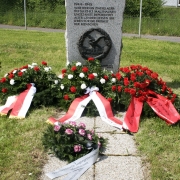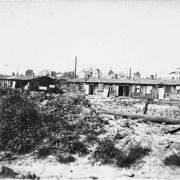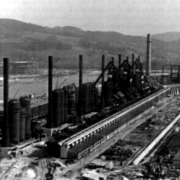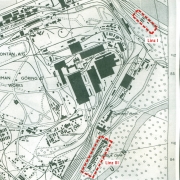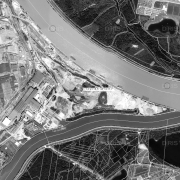Satellite Camp Linz I
Gründung des Konzentrationslagers
As of December 1942, a group of prisoners (approx. 30 men) were transported to the site and back from Mauthausen every day, to set up the camp. On 11 January 1943, a total of 100 prisoners were transferred to the camp, thus officially establishing it as “SS work camp Linz”. The name “Linz I” was not established by the SS administration until February 1944, when a second subcamp to Mauthausen Concentration Camp was built in Linz (Linz II).
Lokalisierung
The prisoners were housed in four solid buildings that they had to build themselves on the premises of the Linz ironworks. The camp was located between the factory premises and the Danube river (see Pictures - Topography).
Informationen über die Häftlinge
By late July 1943, more than 700 prisoners had arrived at Linz I; however, due to return transfers to Mauthausen, the official number of prisoners was “only” approx. 570. In the spring of 1944, the number continued to rise and reached its maximum with 950 people in July 1944. A total of 129 deaths were registered.
Zwangsarbeit
The prisoners had to work on building and in the production of the slag exploitation plant of DEST (Deutsche Erd- und Steinwerke; German Earth and Stone Works). They produced basic building materials and slag stones for barracks construction. The working conditions were extremely bad, and accidents were common (i.e. prisoners fell into the slag pits). Moreover, work took place outside for the most part, which made it even harsher for the prisoners: Summer was unbearably hot, winter bitterly cold. Ing. Schramek from DEST was plant manager; there was also an accountant, the SS-Unterscharführer (Junior Squad Leader) Mr Staufenbeil in command, and about 30 civil employees.
Bewachung
SS-Obersturmführer (Senior Assault Leader) Fritz Miroff was camp leader. SS-Oberscharführer (Senior Squad Leader) Hermann Sturm was Rapportführer (Report Leader) for Linz I and Linz III. The two of them, as well as the SS guards lived next to the works premises in their own barrack.
Schließung
Reichswerke Hermann Göring wanted to expand the use of prisoners in the workforce considerably, but Linz I Subcamp was much too small. Originally, it was to be closed down shortly after the completion of Linz III Subcamp. On 25 July 1944, the ironworks Linz and Oberdonau were severely damaged in air raids by the allied forces. Among the prisoners (Linz I and III), there was a total of 138 deaths and 32 missing persons; the fate of another 68 prisoners remains unknown. After the air raid, any further use of Linz I Subcamp was out of the question. Therefore, the 631 remaining prisoners were transferred to Linz III Subcamp on 3 August 1944. Linz I was thus officially shut down.
Gedenken und Erinnern
The Amicale de Mauthausen, an association of French survivors, erected a memorial stone near the premises of Linz III Subcamp in 1965. The memorial stone was later moved to the parking lot of the VOEST sports centre, and in 1999, an outdoor exhibition on the history of the Linz I and III camps was added. The exhibit was later destroyed in a thunderstorm. One memorial stone for the subcamps near the Reichswerke remains today, on the premises of former Linz III Subcamp. There is also a permanent exhibition at the Museum for Contemporary History [1] in Linz. The date for the annual memorial ceremony can be found in the MKÖ programme for commemoration and liberation ceremonies [2].

